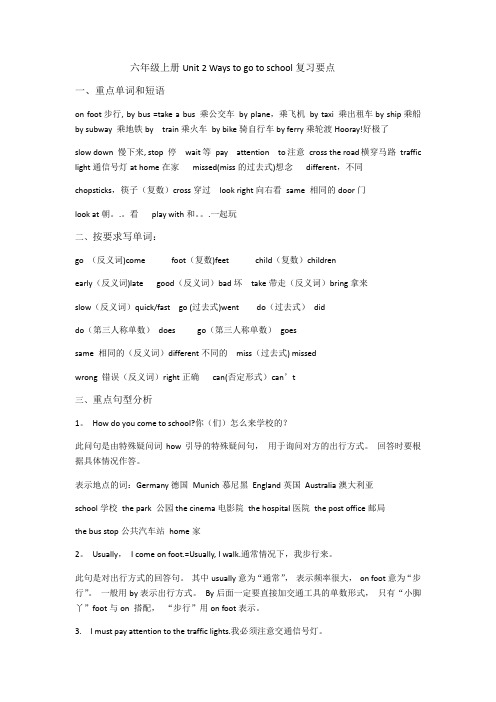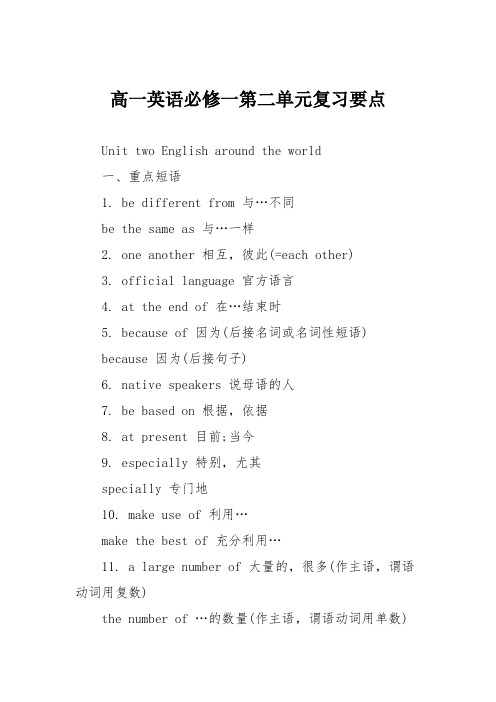Unit2 复习要点
- 格式:ppt
- 大小:333.50 KB
- 文档页数:65

六年级上册Unit 2 Ways to go to school复习要点一、重点单词和短语on foot步行, by bus =take a bus 乘公交车by plane,乘飞机by taxi 乘出租车by ship乘船by subway 乘地铁by train乘火车by bike骑自行车by ferry乘轮渡Hooray!好极了slow down 慢下来, stop 停wait等pay attention to注意cross the road横穿马路traffic light通信号灯at home在家missed(miss的过去式)想念different,不同chopsticks,筷子(复数)cross穿过look right向右看same 相同的door门look at朝。
.。
看play with和。
.一起玩二、按要求写单词:go (反义词)come foot(复数)feet child(复数)childrenearly(反义词)late good(反义词)bad坏take带走(反义词)bring拿来slow(反义词)quick/fast go (过去式)went do(过去式)diddo(第三人称单数)does go(第三人称单数)goessame 相同的(反义词)different不同的miss(过去式) missedwrong 错误(反义词)right正确can(否定形式)can’t三、重点句型分析1。
How do you come to school?你(们)怎么来学校的?此问句是由特殊疑问词how引导的特殊疑问句,用于询问对方的出行方式。
回答时要根据具体情况作答。
表示地点的词:Germany德国Munich慕尼黑England英国Australia澳大利亚school学校the park 公园the cinema电影院the hospital医院the post office邮局the bus stop公共汽车站home家2。

八下英语第二单元重点
八年级下册英语第二单元的重点内容包括以下几个方面:
1. 词汇,这个单元涉及到一些新的词汇,包括动词、名词、形
容词和副词等。
学生需要掌握这些词汇的拼写、发音和用法,例如
关于旅行、假期和交通工具的词汇。
2. 语法,这个单元的语法重点可能包括进行时态、一般过去时
和现在完成时等。
学生需要理解这些时态的构成和用法,并能够在
句子中正确地运用它们。
3. 阅读理解,在这个单元,学生可能需要阅读一些关于旅行经历、假期计划或者交通工具的文章或故事。
他们需要理解文章的主旨,抓住关键信息,并回答相关问题。
4. 听力,学生可能需要通过听力练习来提高自己的听力理解能力,包括听取旅行信息、假期计划或者交通指示等内容,并做出相
应的回答或反应。
5. 写作,学生可能需要进行一些与旅行或假期相关的写作练习,
比如写一篇关于自己假期计划的短文或者写一封给朋友的电子邮件,分享旅行经历。
总的来说,这个单元的重点是让学生掌握与旅行、假期和交通
工具相关的词汇、语法和表达能力,培养他们的阅读理解和听力理
解能力,同时提高他们的写作能力。
希望这些内容能够帮助你更好
地理解这个单元的重点。

鲁科版英语五上Unit2Feelings复习要点词汇分类总结四、本单元“情绪”词汇总结Unit2 Feelings知识点总结Lesson1 He’s excited.“look”看起来,看上去2.We are going to the park. be going to ... 计划...,打算...3.—What’s Danny doing there?—He’s dancing in the rain. (dancing:dance的进行式)现在进行时态:主语+be+动词ing形式例句:I’m watching a football game.lost:lose的过去式,表示“丢失”I’ve:I haveLesson2 Was he happy?1.I’m late. late:晚的,迟的with:和...在一起with和and:都表示“和”,用法区别:例句:Wang Hong and Jenny go to the park.(and前后为并列主语,用在事件前)Wang Hong go to the park with Jenny.(with用在事件描述之后)played:play的过去式Lesson3 Wang Hong is worried.1.It’s time for school. “It’s time for...”到了...时间了3.She can’t find(找到)【saw:是动词see的过去式】因句中yesterday“昨天”,所以用一般过去时态。
5.“...”her mother says. 【says:say的第三人称单数】6. Huanhuan comes in. 【comes: come的第三人称单数】7. She has a book in her mouth. 【has: have的第三人称单数】Lesson4 Again, please.1.单元词汇拓展:different不同的+名词复数stay 停留become开始变得,成为easily容易地,简单地calm宁静的peaceful安宁的2.But sometimes blue may make us sad.(1)make让...;使得某人......, make us用法:动词后用宾格(2)us:“我们”,是主格we的宾格形式。

高一英语必修一第二单元复习要点Unit two English around the world一、重点短语1. be different from 与…不同be the same as 与…一样2. one another 相互,彼此(=each other)3. official language 官方语言4. at the end of 在…结束时5. because of 因为(后接名词或名词性短语)because 因为(后接句子)6. native speakers 说母语的人7. be based on 根据,依据8. at present 目前;当今9. especially 特别,尤其specially 专门地10. make use of 利用…make the best of 充分利用…11. a large number of 大量的,很多(作主语,谓语动词用复数)the number of …的数量(作主语,谓语动词用单数)12. in fact = actually= as a matter of fact 事实上13. believe it or not 信不信由你14. there is no such thing as… 没有这样的事…15. be expected to …被期待做某事16. play a part/role in … 在…起作用17. make lists of…列清单18. included 包括(前面接包括的对象)Including包括(后接包括的对象)19. command sb. to do sth. 命令某人去做某事command + that 从句(从句用should+V原)20. request sb. to do sth. 要求某人做某事request + that 从句(从句用should+V原)二、语法----英语中的命令(command)语气和请求(request)语气命令语气:表示直接命令某人做某事,语气比较重,不怎么礼貌,一般用于上级对下级例:1. “ Look at the example”, the teacher said to us.2. Open the window!请求语气:表示请求某人做某事,语气比较缓和,非常礼貌例:1. “ Would you like to see my flat?” She asked. 2. Would you please open the window?高一英语第二单元复习要点就为大家提供这些,请关注!2016学年高一英语上册期中必备知识点高一英语上册期中必备知识点总结:75个必背句型。

人教PEP英语五年上册第二单元Unit2My week知识点归纳及复习要点附单元练习第二单元Unit2My week知识点归纳一、核心词汇1.表示星期的名词:Sunday(Sun.)星期日Monday(Mon.)星期一Tuesday(Tues.)星期二Wednesday(Wed.)星期三Thursday(Thur.)星期四Friday(Fri.)星期五Saturday(Sat.)星期六weekend周末2.常见动词:wash洗watch看do做;干read看;读play踢;玩;参加(体育运动)3、短语:wash my clothes洗我的衣服watch TV看电视do homework做作业read books看书play football踢足球二、了解词汇1.单词:cooking烹饪;烹调often时常;常常park公园tired疲倦的sport体育运动every每一个,每个day一天;一日schedule工作计划;日程安排should(用于纠正别人)应该,应当2.短语:play sports做体育运动三、核心句型1.—What do you have on Thursdays?星期四你有什么课?—I have maths,English and music.我有数学、英语和音乐课。
解读:这是用来询问某人某天课程安排的句型。
应根据实际情况回答。
举一反三:—What do you have on Mondays?星期一你们有什么课?—We have Chinese,English and PE.我们有语文、英语和体育课。
2.—What do you do on Thursdays,Grandpa?爷爷,星期四你做什么?—Oh,I have a cooking class with your grandma!噢,我和你奶奶有堂烹饪课!解读:此句型用来询问某人的日常安排,第一个do为助动词,第二个do是实义动词。

Unit 2 What time do you go to school?重点单词,向上,穿衣服连衣裙,刷,牙齿,淋浴淋浴器,通常的,冲动,早,50,工作,电台车站,夜晚,滑稽可笑的,练习锻炼,最好的,一半半数,晚于,家庭作业,群,生活生命,跑,有时,大量的,打扫,行走,很快的,有 ------味道?短语归纳1. what time 几点2. go to school 去上学3. get up 起床4. take a shower 洗淋浴5. brush teeth 刷牙6. get to 到达7. do homework 做家庭作业8. go to work 去上班9. go home 回家10. eat breakfast 吃早饭11. get dressed 穿上衣服12. get home 到家13. either ⋯ or要⋯么⋯要么⋯14. go to bed 上床睡觉15. in the morning/ afternoon/ evening 在上午 / 下午 / 晚上16. take a walk 散步17. lots of=a lot of 许多,大量18. radio station 广播电台19. at night 在晚上20. be late for=arrive late for迟到◆用法1. at +具体时间点在几点(几分)2. eat breakfast/ lunch/dinner吃早饭 /午饭/晚饭3. thirty\half past +基数词⋯⋯点半4. fifteen\a quarter to + 基数词差一刻到⋯⋯点5. take a/an + 名词从事⋯⋯活动6. from⋯ to ⋯从⋯⋯到⋯⋯7. need to do sth需要做某事重点句子1.你通常几点洗澡?我通常6:40 洗澡2. SCOTT有一个有趣的工作. 他在电台工作3.他每天从下午 3 点工作到 6 点4.那真是一个滑稽的早饭时间5.我通常早上六点钟锻炼,6.我上班从来不迟到。
仁爱英语七年级Unit 2复习纲要与配套练习本单元讲解要点一.词汇部分come from, give…to…, look like, look at, look the same. look different二.语法部分:1.have、hasI have a small nose. We /You/They have round faces.Do you have a knife? Yes,Ido./No,I don’t.He/She/It has big ears.Does she have small hands? Yes,she does. No,she doesn’t.Whose cap is it? It’s Sally’s. Whose bananas are these?They’re their bananas /theirs.三.句型部分:Oh,I know/see.Yes,you’re right.Who is your favorite movie star? It’s Bruce Lee.Guess again.I come from England.We are in the same school,but in different grades.But you look the same.Please give this letter to Maria. I’ll give it to her.The girl in yellow is Maria.He is in a black cap and blue shoes.I think it’s kangkang’s/Li ming’s.We look the same,but we are in different clothes.Please help us find him.随堂练习:一、单项选择。
(10题,每小题2分,满分20分)( )1. —____ jacket is this?—I think it’s Mingming’s.A. WhoB. Who’sC. Whose( )2.Those girls _____ long hair.A.hasB.have.C.are.( )3. —Is it your dress?—No. It’s ____.A. hersB. herC. my( )4. —What color is the T-shirt?—It’s ____.A. an orangeB. orangeC. the orange( )5. The girl ____ black is my sister.A. inB. atC. to( )6. —Is this Tom’s bike?—____, I don’t know.A. OKB. GoodC. Sorry( )7. Mary is in ____ red clothes and her hair ____ brown.A. /; isB. a; areC. /; are( )8. —Do you look like your sister?—No, we ____.A. look the sameB. look differentC. look like( )9. —You are nice in this dress.—____A. It’s right.B. No, it isn’t.C. Thank you.( )10.-What does your brother look like?-She has _____nose.A.a big red B .a red big C.red big二、词汇运用。
Unit 2 My Days of the Week一、四会单词词汇表Mondy 星期一Tuesday 星期二Wednesday 星期三Thursday 星期四Friday 星期五Saturday 星期六Sunday 星期天day 天have 有、吃on 在…..时候do homework 做作业watch TV 看电视read books 读书二. 五会句型的要求为:会说、会读、会用、会翻译、能做连词成句。
(一般学习中等偏上的同学都要求做到五会)1.What classes do you have?你们今天有什么课?注意提问要用复数2.What do we have on Mondays?每周一我们有什么课?注意Mondays的翻译是每周一3.We have English, math and P.E.我们有英语,数学和体育。
三个以上的名词或者形容词要注意最后两项之间加and4.- What day is it today?今天星期几?- It’s Monday.最基础的问法要会它的一问一答5.I like weekends.我喜欢周末。
注意周末是很多天,必须要加s6.What day is it tomorrow?明天星期几?What day is tomorrow?两种说法都对7.Tomorrow is Thursday.明天是星期四。
It’s Thursday tomorrow.两种说法都对8.I often paint or watch TV.我经常画画或者看电视。
注意or是或者的意思9.Saturday is fun for me!星期六对我来说很有趣。
很口语的表达方式。
10.Sunday is sweet for me!星期天对我来说很甜蜜。
很口语的表达方式。
11.It’s time to get up.要会用it’s time to来造句12.I love Saturdays!很口语的表达方式。
1.英语钟点时刻的表达在英语中,钟点时刻的表达除了用阿拉伯数字(如8:10,12:45)外,还可以用以下几种表达方式。
◆当时间是整点时,可用“钟点数+o'clock”来表达,其中o'clock可以省略。
如:6:00 → six (o'clock) 11:00 → eleven (o'clock)◆当时间不是整点时,表达方式有以下两种:1. 钟点数+分钟数。
如:9:08 → nine eight 14:40 → fourteen forty2. 分钟数+ past / to +钟点数1) 当分钟数小于30时,用“分钟数+ past +钟点数”表示“几点过几分”。
如:8:09 → nine past eight7:25 → twentyfive past seven2) 当分钟数大于30时,用“(60-分钟数) + to +下一个钟点数”表示“差几分到几点”。
如:11:40 → twenty to twelve 2:58 → two to three注意:在分钟数中,15分钟还可以用a quarter表示,30分钟还可以用half来表示。
如:11:15 → a quarter past eleven8:45 → a quarter to nine13:30 → half past thirteen◆ A.M.(a.m.)和P.M.(p.m.)在12小时制中,我们可以用A.M.(a.m.)和P.M.(p.m.)来区分上、下半天。
A.M.(a.m.)意为“午前、上午”; P.M.(p.m.)意为“午后、下午”。
如:早上六点半→ 6:30 a.m. / half past six in the morning中午十二点→ 12:00 p.m. / 12 o'clock in the daytime午夜十二点→ 12:00 a.m. / 12 o'clock at night / at midnight【运用】用两种方式写出下列时间的英语表达1. 2. 3.___________________ 或___________________ ___________________或______________________________________或___________________参考答案1. four thirty; half past four2. eleven five; five past eleven3. nine fifteen; a quarter past nine2. what time & when 引导的特殊疑问句what time和when均可对时间状语进行提问,用来询问什么时间。